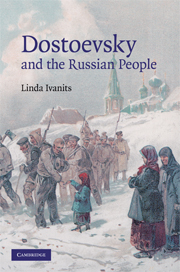Book contents
- Frontmatter
- Contents
- Acknowledgments
- Note on transliteration
- Introduction: the people in Dostoevsky's art and thought
- 1 The face of the people, 1821–1865
- 2 The world of the people in Crime and Punishment
- 3 The Idiot: where have all the people gone?
- 4 Fumbling toward Holy Russia in The Devils
- 5 Back in Russia: the face of the people, 1871–1877
- 6 The Brothers Karamazov: Christ walks the Russian land
- Concluding remarks: Dostoevsky and the people
- Notes
- Bibliography
- Index
5 - Back in Russia: the face of the people, 1871–1877
Published online by Cambridge University Press: 22 September 2009
- Frontmatter
- Contents
- Acknowledgments
- Note on transliteration
- Introduction: the people in Dostoevsky's art and thought
- 1 The face of the people, 1821–1865
- 2 The world of the people in Crime and Punishment
- 3 The Idiot: where have all the people gone?
- 4 Fumbling toward Holy Russia in The Devils
- 5 Back in Russia: the face of the people, 1871–1877
- 6 The Brothers Karamazov: Christ walks the Russian land
- Concluding remarks: Dostoevsky and the people
- Notes
- Bibliography
- Index
Summary
In April 1867, Dostoevsky and his young bride Anna Grigorevna left Russia planning to remain abroad for several months. They returned only in July 1871. This extended self-exile was one of the most creative periods in the writer's life. Somehow, in the midst of intense homesickness, epileptic seizures, gambling bouts, financial strains, the death of his first daughter, and the birth of his second, Dostoevsky managed to write The Idiot and much of The Devils. This period also saw the growth of his messianic dreams for Russia and the deepening of his hostility toward western Europe. In his letters to A. N. Maikov, he accused the Catholic Church of assuming the might of the Roman Empire and distorting the image of Christ; and he spoke of Orthodoxy as the “light from the East” that would regenerate Europe after Russia had asserted “political supremacy over the entire Slavic world” (29, 1: 146–47; 28, 2: 260, Dostoevsky's emphasis). His letters of this time display the sharpened acrimony toward the liberal and radical intelligentsia so manifest in The Devils. One can probably take the words of Peter Verkhovensky (Nechaev) in the Notebooks to The Devils as a reflection of the writer's own anxiety about the revolutionary movement: he suspected that its true intent was “to eradicate Christianity in order to begin a new life without God” (11: 106).
- Type
- Chapter
- Information
- Dostoevsky and the Russian People , pp. 133 - 158Publisher: Cambridge University PressPrint publication year: 2008



